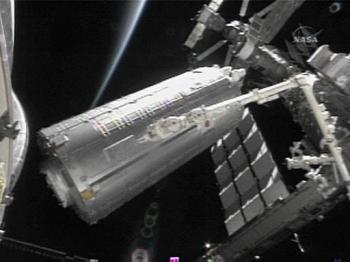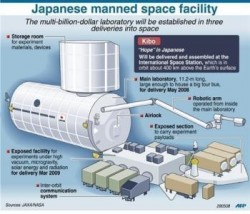The brand new Japanese science laboratory was attached to the International Space Station today (Tuesday). Space Shuttle Discovery’s STS-124 mission launched on May 31st (Saturday) has quickly gotten down to business, unloading the huge 11.2 meter-long lab using the station’s robotic arm. This is the second component of Kibo (Japanese for “Hope”) to be attached to the station, the first was a logistics module sent to the station by Endeavour in March. The third and final part of the lab, a facility that will allow outdoor experiments be exposed to space, will be delivered some time next year. The lab will be “switched on” and ready for occupation tomorrow (Wednesday) at 20:52 GMT.
Kibo is the largest module to be attached to the ISS so far. It is over two meters longer than NASA’s Destiny module (at 8.5 meters) and dwarfs ESA’s Columbus facility (at 6.8 meters long) attached back in February. The new lab will provide enough space for four astronauts to work in and gives Japan a key foothold in the science carried out on the station.
The 15 tonne lab was prepared for attachment by a six-hour spacewalk by US astronauts Mike Fossum and Ron Garan and the station’s robotic arm was controlled by Japanese astronaut Akihiko Hoshide and US astronaut Karen Nyberg.
Kibo has been designed to carry out an impressive variety of experiments into space medicine, biology and biotechnology, material production and communications. This research will be located inside and outside of the module so the tests can be carried out in a pressurized environment and exposed to the vacuum of space. A 10 meter-long robotic arm will also be attached by the STS-124 and ISS crew so experiments can be manipulated outdoors by a controller inside.
View the NASA video and commentary on the successful attachment of Kibo »
According to mission controllers, the delivery of Kibo went according to plan. However, the spacewalk by Fossum and Garan was delayed by an hour, but they managed to make up for lost time. Firstly they had to detach a shuttle inspection boom from the station that had been left behind by the previous shuttle mission in March. Used to check for damage to the protective ceramic tiles on the underbelly of the shuttle, the boom had been left there as there was no room in Discovery’s cargo bay.
Apart from delivering this important laboratory, the crew had two more gifts: a toy Buzz Lightyear and a highly valuable toilet pump – both very important payloads in very different ways…
Sources: AFP, BBC



Cool – though i did think the director lacked narrative impetus about halfway through, and the charaterisations could’ve benefitted from being more complete, butstill a brave effort.
Is there a bigger picture of that drawing somewhere ? I can only read the top 3 lines,
and I would like to know what that thing on top of the Kibo module is…
Hi HenkZw:
I have found an alternative higher-res image: http://spaceflight.nasa.gov/gallery/images/station/jem/html/jsc2003e42552.html
I can’t find a hi-re one like to pic in the article, but if I come across it I’ll let you know 🙂
Cheers, Ian
Kibo is a sad reminder of the science that the station could have done, considering it was originally supposed to be the smallest module.
Ian,
thanks for pointing me to this excellent image!
whats the main use of kibo?